英语说课 听说课型
- 格式:doc
- 大小:25.50 KB
- 文档页数:5
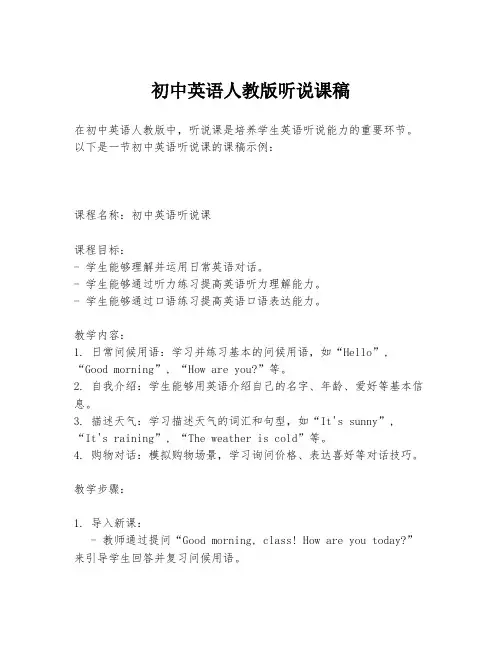
初中英语人教版听说课稿在初中英语人教版中,听说课是培养学生英语听说能力的重要环节。
以下是一节初中英语听说课的课稿示例:课程名称:初中英语听说课课程目标:- 学生能够理解并运用日常英语对话。
- 学生能够通过听力练习提高英语听力理解能力。
- 学生能够通过口语练习提高英语口语表达能力。
教学内容:1. 日常问候用语:学习并练习基本的问候用语,如“Hello”, “Good morning”, “How are you?”等。
2. 自我介绍:学生能够用英语介绍自己的名字、年龄、爱好等基本信息。
3. 描述天气:学习描述天气的词汇和句型,如“It's sunny”,“It's raining”, “The weather is cold”等。
4. 购物对话:模拟购物场景,学习询问价格、表达喜好等对话技巧。
教学步骤:1. 导入新课:- 教师通过提问“Good morning, class! How are you today?”来引导学生回答并复习问候用语。
2. 听力练习:- 播放一段关于自我介绍的听力材料,学生听后回答问题,如“What's his/her name?”, “How old is he/she?”等。
3. 口语练习:- 学生分组进行自我介绍的口语练习,每组选出一名代表在全班前展示。
4. 情景模拟:- 教师创设一个购物的情景,学生分组进行角色扮演,练习购物对话。
5. 课堂小结:- 教师总结本节课的重点内容,并鼓励学生在日常生活中多使用英语进行交流。
6. 作业布置:- 学生回家后与家人用英语进行一次自我介绍,并记录下家人的反应和自己的体会。
教学方法:- 互动式教学:鼓励学生参与课堂活动,通过角色扮演、小组讨论等形式提高学生的参与度。
- 多媒体教学:利用音频、视频等多媒体材料辅助教学,提高学生的学习兴趣。
教学资源:- 教材:人教版初中英语教材- 音频材料:自我介绍的听力练习录音- 视频材料:购物场景模拟视频评估方式:- 课堂表现:学生在口语练习和情景模拟中的参与度和表现。
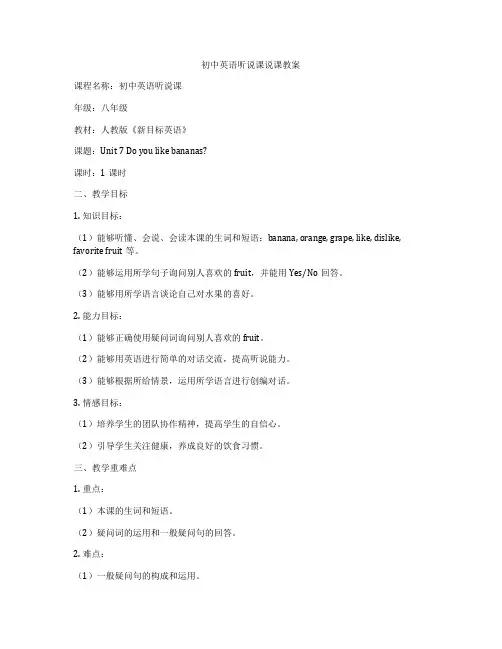
初中英语听说课说课教案课程名称:初中英语听说课年级:八年级教材:人教版《新目标英语》课题:Unit 7 Do you like bananas?课时:1课时二、教学目标1. 知识目标:(1)能够听懂、会说、会读本课的生词和短语:banana, orange, grape, like, dislike, favorite fruit等。
(2)能够运用所学句子询问别人喜欢的 fruit,并能用Yes/No回答。
(3)能够用所学语言谈论自己对水果的喜好。
2. 能力目标:(1)能够正确使用疑问词询问别人喜欢的 fruit。
(2)能够用英语进行简单的对话交流,提高听说能力。
(3)能够根据所给情景,运用所学语言进行创编对话。
3. 情感目标:(1)培养学生的团队协作精神,提高学生的自信心。
(2)引导学生关注健康,养成良好的饮食习惯。
三、教学重难点1. 重点:(1)本课的生词和短语。
(2)疑问词的运用和一般疑问句的回答。
2. 难点:(1)一般疑问句的构成和运用。
(2)情态动词 like 的用法。
四、教学过程1. 课前准备(1)准备与水果相关的水果图片和视频。
(2)准备录音机、磁带或音频文件。
(3)准备教学课件。
2. 课堂导入(1)向学生问候,引入课堂。
(2)通过展示水果图片和视频,引导学生谈论水果。
(3)利用问题引入本课主题:“Do you like bananas?”。
3. 新课呈现(1)呈现生词和短语,如banana, orange, grape, like, dislike, favorite fruit等,并进行认读练习。
(2)通过问答形式,引导学生运用疑问词询问别人喜欢的 fruit。
(3)讲解一般疑问句的构成和回答方式。
4. 听力训练(1)播放录音,让学生听懂对话内容。
(2)学生跟读对话,模仿语音语调。
(3)进行听力练习,如判断对错、选择答案等。
5. 口语练习(1)分组进行角色扮演,让学生运用所学语言进行对话。

人教新目标英语听说课说课模板一、课程概述本课程为人教新目标英语听说课,旨在培养学生的英语听说能力,提高他们的口语表达水平。
课程以英语为教学语言,通过多样化的教学活动,帮助学生掌握基本的听说技能,培养跨文化交流意识,提升英语综合能力。
二、教学目标1. 培养学生具备基本的听说能力,能够正确理解并表达日常生活中的简单对话。
2. 帮助学生掌握常用的表达方式,提高口语表达的流利度和准确性。
3. 培养学生的跨文化交流意识,让他们了解中西方文化差异,提高跨文化交流能力。
4. 培养学生的自主学习能力,让他们学会如何有效地进行听说训练。
三、教学内容与重难点1. 教学内容:本课程主要包括以下四个方面:a. 听力训练:通过听录音、观看视频等方式,培养学生的听力技巧,提高他们的听力水平。
b. 口语表达:通过模仿、角色扮演、讨论等方式,培养学生的口语表达能力,提高他们的口语水平。
c. 跨文化交流:通过比较中西方文化差异,培养学生的跨文化交流意识,提高他们的跨文化交流能力。
d. 自主学习:通过引导学生制定学习计划、选择合适的学习资源等方式,培养学生的自主学习能力。
2. 教学重难点:a. 听力训练中的听力技巧和听力理解能力是教学重点。
b. 口语表达中的语音语调、流利度和准确性是教学难点。
c. 跨文化交流中的文化差异意识和交流技巧是教学重点。
d. 自主学习中的学习策略和学习计划是教学难点。
四、教学方法与手段1. 教学方法:本课程采用以下教学方法:a. 情境模拟法:通过模拟真实情境,让学生在实际场景中学习和运用英语。
b. 任务驱动法:通过布置实际任务,让学生在完成任务的过程中学习和运用英语。
c. 游戏教学法:通过设计英语游戏,让学生在游戏中学习和运用英语。
d. 个性化教学法:根据学生的个性特点和需求,采用不同的教学方式和手段,让学生更好地学习和运用英语。
2. 教学手段:本课程采用以下教学手段:a. 多媒体教学:使用投影仪、音响等设备播放教学资料,提高教学效果。
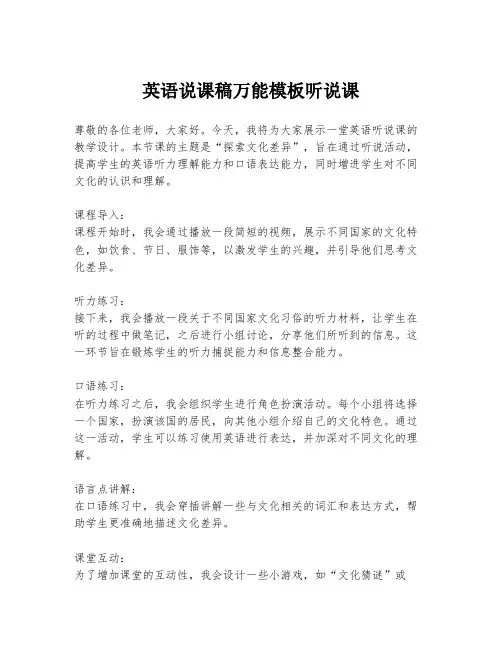
英语说课稿万能模板听说课尊敬的各位老师,大家好。
今天,我将为大家展示一堂英语听说课的教学设计。
本节课的主题是“探索文化差异”,旨在通过听说活动,提高学生的英语听力理解能力和口语表达能力,同时增进学生对不同文化的认识和理解。
课程导入:课程开始时,我会通过播放一段简短的视频,展示不同国家的文化特色,如饮食、节日、服饰等,以激发学生的兴趣,并引导他们思考文化差异。
听力练习:接下来,我会播放一段关于不同国家文化习俗的听力材料,让学生在听的过程中做笔记,之后进行小组讨论,分享他们所听到的信息。
这一环节旨在锻炼学生的听力捕捉能力和信息整合能力。
口语练习:在听力练习之后,我会组织学生进行角色扮演活动。
每个小组将选择一个国家,扮演该国的居民,向其他小组介绍自己的文化特色。
通过这一活动,学生可以练习使用英语进行表达,并加深对不同文化的理解。
语言点讲解:在口语练习中,我会穿插讲解一些与文化相关的词汇和表达方式,帮助学生更准确地描述文化差异。
课堂互动:为了增加课堂的互动性,我会设计一些小游戏,如“文化猜谜”或“文化知识问答”,让学生在轻松愉快的氛围中学习。
总结反馈:课程的最后,我会让学生分享他们对本节课的感想和收获,同时对他们的表现给予积极的反馈和建议。
作业布置:作为课后作业,我将要求学生准备一个简短的演讲,介绍他们自己国家的文化特色,以巩固课堂所学,并在下一节课上进行展示。
通过这堂英语听说课,学生不仅能够提高英语听说能力,还能增进对世界各地文化的了解和尊重。
我相信,通过这样的教学设计,学生能够在轻松愉快的氛围中获得知识,享受学习的过程。
谢谢大家的聆听,期待与大家共同探讨更多的教学方法和策略。
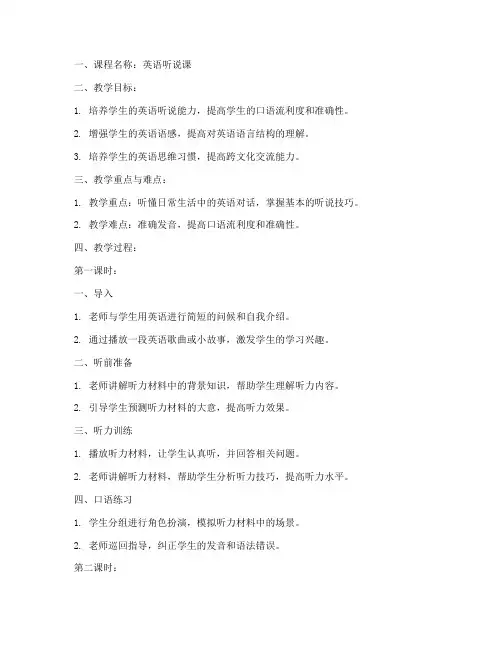
一、课程名称:英语听说课二、教学目标:1. 培养学生的英语听说能力,提高学生的口语流利度和准确性。
2. 增强学生的英语语感,提高对英语语言结构的理解。
3. 培养学生的英语思维习惯,提高跨文化交流能力。
三、教学重点与难点:1. 教学重点:听懂日常生活中的英语对话,掌握基本的听说技巧。
2. 教学难点:准确发音,提高口语流利度和准确性。
四、教学过程:第一课时:一、导入1. 老师与学生用英语进行简短的问候和自我介绍。
2. 通过播放一段英语歌曲或小故事,激发学生的学习兴趣。
二、听前准备1. 老师讲解听力材料中的背景知识,帮助学生理解听力内容。
2. 引导学生预测听力材料的大意,提高听力效果。
三、听力训练1. 播放听力材料,让学生认真听,并回答相关问题。
2. 老师讲解听力材料,帮助学生分析听力技巧,提高听力水平。
四、口语练习1. 学生分组进行角色扮演,模拟听力材料中的场景。
2. 老师巡回指导,纠正学生的发音和语法错误。
第二课时:一、复习上节课所学内容1. 学生用英语进行简短的自我介绍,巩固发音和语法。
2. 老师提问,检查学生对上节课听力材料的掌握情况。
二、听力训练1. 播放新的听力材料,让学生认真听,并回答相关问题。
2. 老师讲解听力材料,帮助学生分析听力技巧,提高听力水平。
三、口语练习1. 学生分组进行角色扮演,模拟听力材料中的场景。
2. 老师巡回指导,纠正学生的发音和语法错误。
四、总结与反馈1. 老师对本节课的学习情况进行总结,表扬优秀学生,指出不足之处。
2. 学生提出疑问,老师进行解答。
五、作业布置1. 完成听力材料中的练习题。
2. 准备下节课的角色扮演。
六、教学反思1. 本节课通过听力材料和口语练习,提高了学生的英语听说能力。
2. 在教学过程中,要注意培养学生的英语思维习惯,提高他们的跨文化交流能力。
3. 针对学生的发音和语法错误,要进行及时纠正和指导。
七、教学资源1. 英语听力材料:教材、网络资源等。
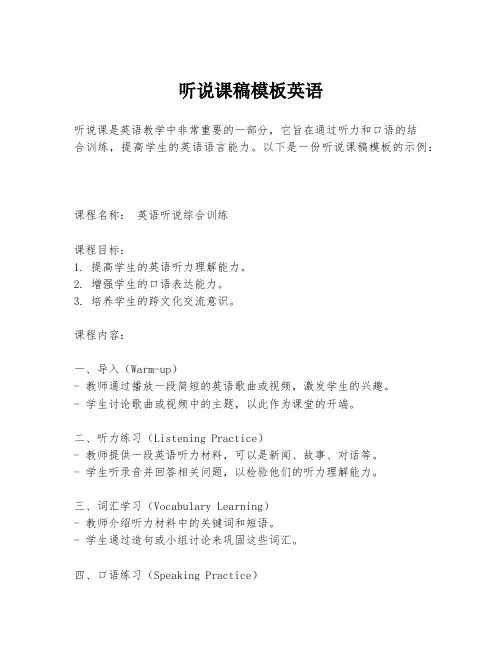
听说课稿模板英语听说课是英语教学中非常重要的一部分,它旨在通过听力和口语的结合训练,提高学生的英语语言能力。
以下是一份听说课稿模板的示例:课程名称:英语听说综合训练课程目标:1. 提高学生的英语听力理解能力。
2. 增强学生的口语表达能力。
3. 培养学生的跨文化交流意识。
课程内容:一、导入(Warm-up)- 教师通过播放一段简短的英语歌曲或视频,激发学生的兴趣。
- 学生讨论歌曲或视频中的主题,以此作为课堂的开端。
二、听力练习(Listening Practice)- 教师提供一段英语听力材料,可以是新闻、故事、对话等。
- 学生听录音并回答相关问题,以检验他们的听力理解能力。
三、词汇学习(Vocabulary Learning)- 教师介绍听力材料中的关键词和短语。
- 学生通过造句或小组讨论来巩固这些词汇。
四、口语练习(Speaking Practice)- 学生分组进行角色扮演或情景对话,使用所学词汇和表达。
- 教师提供指导和反馈,帮助学生改进发音和语言运用。
五、听力复述(Listening Retell)- 学生再次听录音,然后尝试用自己的话复述所听到的内容。
- 教师鼓励学生使用不同的表达方式,以提高语言的灵活性。
六、小组讨论(Group Discussion)- 学生分组讨论与听力材料相关的话题,鼓励使用英语进行深入交流。
- 教师巡视各组,提供必要的帮助和指导。
七、总结(Summary)- 教师总结本节课的重点和学生的表现。
- 学生分享自己的学习体会和收获。
八、作业(Homework)- 学生需要准备下一次课的听力材料,并预习相关的词汇和表达。
结束语:- 教师鼓励学生在课后继续练习听说技能,并期待他们在下一节课中的表现。
请注意,这只是一个模板,具体的课程内容和活动应根据学生的水平和需求进行调整。
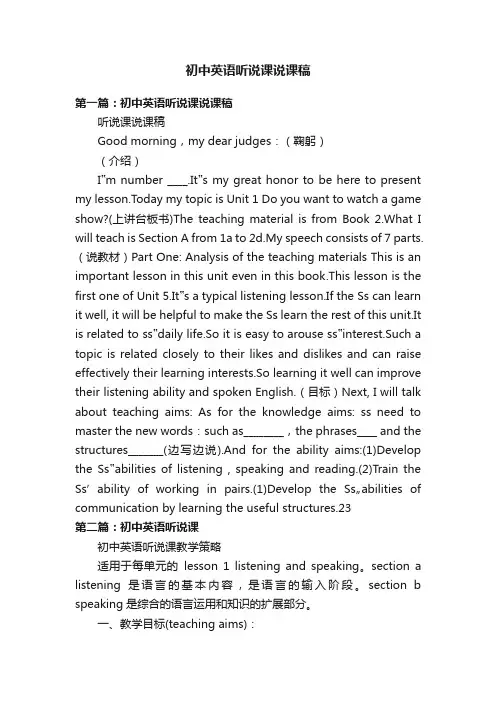
初中英语听说课说课稿第一篇:初中英语听说课说课稿听说课说课稿Good morning,my dear judges:(鞠躬)(介绍)I‟m number ____.It‟s my great honor to be here to present my lesson.T oday my topic is Unit 1 Do you want to watch a game show?(上讲台板书)The teaching material is from Book 2.What I will teach is Section A from 1a to 2d.My speech consists of 7 parts.(说教材)Part One: Analysis of the teaching materials This is an important lesson in this unit even in this book.This lesson is the first one of Unit 5.It‟s a typical listening lesson.If the Ss can learn it well, it will be helpful to make the Ss learn the rest of this unit.It is related to ss‟daily life.So it is easy to arouse ss‟interest.Such a topic is related closely to their likes and dislikes and can raise effectively their learning interests.So learning it well can improve their listening ability and spoken English.(目标)Next, I will talk about teaching aims: As for the knowledge aims: ss need to master the new words:such as________,the phrases____ and the structures_______(边写边说).And for the ability aims:(1)Develop the Ss‟abilities of listening , speaking and reading.(2)Train the Ss’ability of working in pairs.(1)Develop the Ss…abilities of communication by learning the useful structures.23第二篇:初中英语听说课初中英语听说课教学策略适用于每单元的lesson 1 listening and speaking。
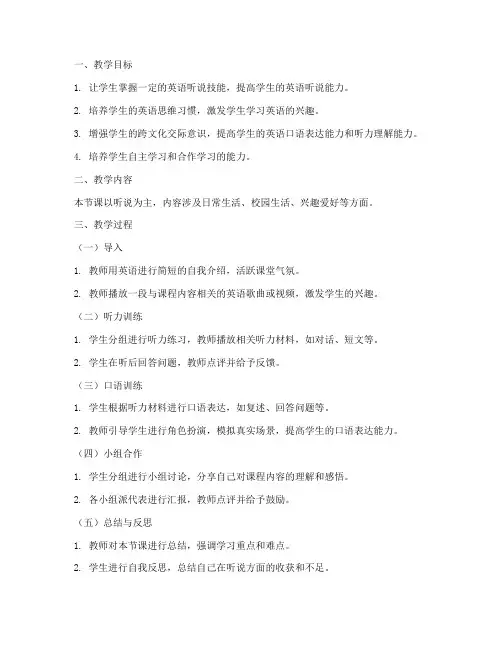
1. 让学生掌握一定的英语听说技能,提高学生的英语听说能力。
2. 培养学生的英语思维习惯,激发学生学习英语的兴趣。
3. 增强学生的跨文化交际意识,提高学生的英语口语表达能力和听力理解能力。
4. 培养学生自主学习和合作学习的能力。
二、教学内容本节课以听说为主,内容涉及日常生活、校园生活、兴趣爱好等方面。
三、教学过程(一)导入1. 教师用英语进行简短的自我介绍,活跃课堂气氛。
2. 教师播放一段与课程内容相关的英语歌曲或视频,激发学生的兴趣。
(二)听力训练1. 学生分组进行听力练习,教师播放相关听力材料,如对话、短文等。
2. 学生在听后回答问题,教师点评并给予反馈。
(三)口语训练1. 学生根据听力材料进行口语表达,如复述、回答问题等。
2. 教师引导学生进行角色扮演,模拟真实场景,提高学生的口语表达能力。
(四)小组合作1. 学生分组进行小组讨论,分享自己对课程内容的理解和感悟。
2. 各小组派代表进行汇报,教师点评并给予鼓励。
(五)总结与反思1. 教师对本节课进行总结,强调学习重点和难点。
2. 学生进行自我反思,总结自己在听说方面的收获和不足。
1. 学生在课堂上的参与度和积极性。
2. 学生对课程内容的理解和掌握程度。
3. 学生在口语表达和听力理解方面的进步。
五、教学资源1. 课本、教学课件、音频、视频等。
2. 网络资源,如英语学习网站、APP等。
六、教学反思1. 教师在课堂上要注意观察学生的反应,及时调整教学策略。
2. 教师要关注学生的个体差异,因材施教。
3. 教师要善于运用多种教学方法,激发学生的学习兴趣。
4. 教师要注重培养学生的自主学习能力和合作学习意识。
通过本节课的教学,学生能够在听说方面有所提高,为今后的英语学习打下坚实的基础。
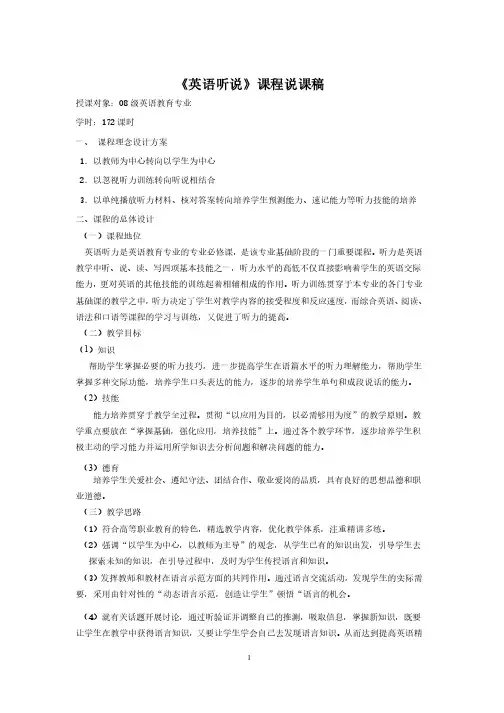
《英语听说》课程说课稿授课对象:授课对象:0808级英语教育专业级英语教育专业学时:学时:172172课时课时一、一、 课程理念设计方案课程理念设计方案1.以教师为中心转向以学生为中心.以教师为中心转向以学生为中心2.以忽视听力训练转向听说相结合.以忽视听力训练转向听说相结合3.以单纯播放听力材料、核对答案转向培养学生预测能力、速记能力等听力技能的培养.以单纯播放听力材料、核对答案转向培养学生预测能力、速记能力等听力技能的培养二、课程的总体设计二、课程的总体设计(一)课程地位(一)课程地位英语听力是英语教育专业的专业必修课,是该专业基础阶段的一门重要课程。
听力是英语教学中听、说、读、写四项基本技能之一,听力水平的高低不仅直接影响着学生的英语交际能力,更对英语的其他技能的训练起着相辅相成的作用。
听力训练贯穿于本专业的各门专业基础课的教学之中,听力决定了学生对教学内容的接受程度和反应速度,而综合英语、阅读、语法和口语等课程的学习与训练,又促进了听力的提高。
语法和口语等课程的学习与训练,又促进了听力的提高。
(二)教学目标(二)教学目标(1)知识)知识帮助学生掌握必要的听力技巧,进一步提高学生在语篇水平的听力理解能力,帮助学生掌握多种交际功能,培养学生口头表达的能力,逐步的培养学生单句和成段说话的能力。
掌握多种交际功能,培养学生口头表达的能力,逐步的培养学生单句和成段说话的能力。
(2)技能)技能能力培养贯穿于教学全过程。
贯彻“以应用为目的,以必需够用为度”的教学原则。
教学重点要放在“掌握基础,强化应用,培养技能”上。
通过各个教学环节,逐步培养学生积极主动的学习能力并运用所学知识去分析问题和解决问题的能力。
极主动的学习能力并运用所学知识去分析问题和解决问题的能力。
(3)德育)德育培养学生关爱社会、遵纪守法、团结合作、敬业爱岗的品质,具有良好的思想品德和职业道德。
业道德。
(三)教学思路(三)教学思路(1)符合高等职业教育的特色,精选教学内容,优化教学体系,注重精讲多练。

7年级英语听说课说课稿在7年级英语听说课程中,我们的目标是培养学生的英语听力和口语表达能力,同时加强他们对英语语言文化的理解。
以下是一节7年级英语听说课的说课稿。
# 课程目标1. 学生能够理解并使用基本的日常英语会话。
2. 学生能够通过听力练习,提高对英语发音和语调的识别能力。
3. 学生能够通过口语练习,增强英语表达的流畅性和准确性。
4. 学生能够了解英语国家的文化习俗,拓宽国际视野。
# 教学内容1. 日常会话:学习基本的问候语、自我介绍、询问和表达需求等。
2. 听力练习:通过听英语歌曲、故事或对话,练习听力理解。
3. 口语表达:进行角色扮演、小组讨论等活动,练习口语表达。
4. 文化介绍:介绍英语国家的节日、风俗习惯等。
# 教学方法1. 互动教学:鼓励学生参与课堂讨论,通过提问和回答提高参与度。
2. 情景模拟:设置不同的场景,让学生在模拟环境中使用英语。
3. 多媒体教学:利用视频、音频等多媒体资源,提高学生的学习兴趣。
4. 小组合作:通过小组合作学习,培养学生的团队协作能力。
# 教学过程1. 导入新课:通过简短的英语歌曲或视频,激发学生的兴趣。
2. 新课呈现:介绍新词汇和句型,通过PPT或黑板展示。
3. 听力练习:播放相关的听力材料,让学生回答问题或复述内容。
4. 口语练习:分组进行角色扮演或情景对话,练习实际应用。
5. 文化分享:介绍相关的英语国家文化,鼓励学生分享自己的见解。
6. 课堂小结:总结本节课的重点内容,布置相关的课后作业。
# 教学评价1. 课堂表现:根据学生的参与度和互动情况给予评价。
2. 听力理解:通过小测验或问答,评估学生的听力理解能力。
3. 口语表达:通过口语练习的表现,评价学生的表达能力和语言运用。
4. 文化理解:通过学生的分享和讨论,了解他们对文化的理解和认识。
# 课后作业1. 完成听力练习,如听写或回答问题。
2. 准备下一次课的角色扮演或情景对话。
3. 阅读指定的英语材料,准备分享自己的见解。
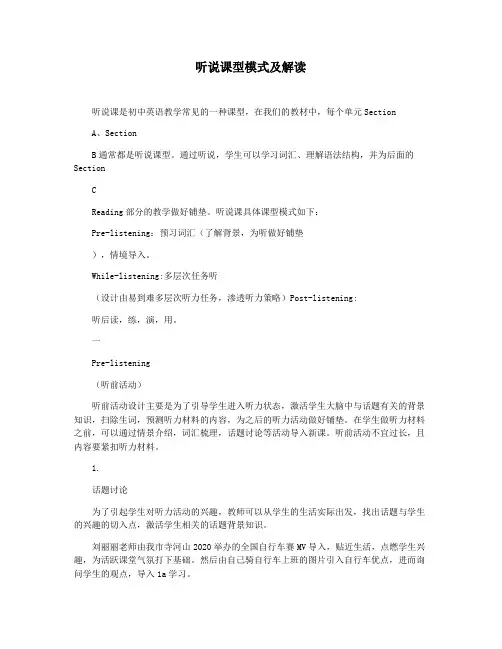
听说课型模式及解读听说课是初中英语教学常见的一种课型,在我们的教材中,每个单元SectionA、SectionB通常都是听说课型。
通过听说,学生可以学习词汇、理解语法结构,并为后面的SectionCReading部分的教学做好铺垫。
听说课具体课型模式如下:Pre-listening:预习词汇(了解背景,为听做好铺垫),情境导入。
While-listening:多层次任务听(设计由易到难多层次听力任务,渗透听力策略)Post-listening:听后读,练,演,用。
一Pre-listening(听前活动)听前活动设计主要是为了引导学生进入听力状态,激活学生大脑中与话题有关的背景知识,扫除生词,预测听力材料的内容,为之后的听力活动做好铺垫。
在学生做听力材料之前,可以通过情景介绍,词汇梳理,话题讨论等活动导入新课。
听前活动不宜过长,且内容要紧扣听力材料。
1.话题讨论为了引起学生对听力活动的兴趣,教师可以从学生的生活实际出发,找出话题与学生的兴趣的切入点,激活学生相关的话题背景知识。
刘丽丽老师由我市寺河山2020举办的全国自行车赛MV导入,贴近生活,点燃学生兴趣,为活跃课堂气氛打下基础。
然后由自己骑自行车上班的图片引入自行车优点,进而询问学生的观点,导入1a学习。
词汇梳理听说课首先要破解词汇关。
听力材料里往往有许多的新单词,为了降低听力难度,在设计活动时,要让学生初步感知生词。
可利用头脑风暴,图片,检测词汇等方式。
荆炜老师从网上搜集了一些与本课词汇有关的图片,目的在于引入本节课的主题,并学习听力材料中的核心生词passengercrazy,pollution等新单词,为接下来的听力活动做准备。
3.创设情境利用实物,教具创设与听力材料相关的情景是最直观,最形象的导入方法,学生会觉得鲜活,真实。
例如罗瑞教师用天安门广场周围的著名建筑物的图片分别放在教室的东西南北,创设了天安门的真实场景,使学生对方位的理解一目了然。
课时:2课时年级:三年级教材:《PEP小学英语》三年级下册课型:新授课教学目标:1. 知识与技能目标:学生能够听懂并正确说出本课所学的单词和句子,能够在日常生活中运用所学知识进行简单的交流。
2. 过程与方法目标:通过听、说、做等多种活动,培养学生良好的英语听说习惯,提高学生的英语口语表达能力。
3. 情感态度与价值观目标:激发学生学习英语的兴趣,培养学生积极参与课堂活动,增强学生的自信心。
教学重难点:1. 重点:正确听懂并说出本课所学的单词和句子。
2. 难点:单词的发音和句子的语调。
教学准备:1. 多媒体课件2. 录音机3. 单词卡片4. 图片素材教学过程:第一课时一、热身活动(Warm-up)1. 教师播放一首简单的英语歌曲,让学生跟随歌曲唱一唱,活跃课堂气氛。
2. 教师组织学生进行简单的自我介绍,复习所学单词。
二、导入新课(Introduction)1. 教师展示与本课主题相关的图片,引导学生猜测图片内容。
2. 教师简要介绍本课所学内容。
三、新课教学(New lesson)1. 教师播放录音,让学生听并跟读单词和句子。
2. 教师带领学生逐个学习单词和句子,并进行发音示范。
3. 教师组织学生进行单词和句子的听写练习。
四、巩固练习(Practice)1. 教师设计简单的听力练习,让学生听录音并回答问题。
2. 教师组织学生进行角色扮演,巩固所学单词和句子。
五、小结与作业(Summary and homework)1. 教师对本课所学内容进行总结,强调重点和难点。
2. 布置课后作业,要求学生复习所学单词和句子,并进行口语练习。
第二课时一、复习导入(Review and introduction)1. 教师组织学生进行单词和句子的听写练习,检查学生对所学知识的掌握情况。
2. 教师带领学生复习本课所学的单词和句子。
二、情景对话(Dialogue in situation)1. 教师播放录音,让学生听并跟读情景对话。
初中英语听说课、精读课说课模板(Word版)1)To XXX.2)XXX.3)XXX.3.Aims on the ns1)To raise Ss’ awareness of the importance of protecting wild animals.2)To cultivate Ss’ XXX.III。
Teaching methods1.Task-based learning: Ss will be XXX.2.Cooperative learning: Ss will XXX.-visual aids: Multimedia resources will be used to create a more XXX.IV。
Study methods1.Active listening: XXX.2.Role-play: XXX.3.Note-taking: Ss will take notes while XXX.V。
Teaching res1.Warm-up: XXX will introduce the topic and ask some XXX’ interest.2.Pre-listening: XXX.3.While-listening: Ss will listen to the。
XXX.4.Post-listening: Ss will share their ns and ideas about the topic and reflect on what they have learned.5.Closure: The teacher will summarize the key points and encourage Ss to apply what they have learned in real life.XXXThe blackboard will be used to display key words。
初中英语听说课说课稿尊敬的各位评委、老师,大家好!今天,我将为大家说课一节初中英语听说课。
本节课的主题是“School Life”,旨在通过对校园生活的探讨,提高学生的英语听说能力,同时加深他们对学校文化的理解。
一、教学目标1. 知识目标:学生能够掌握与学校生活相关的基本词汇和表达方式,如“classroom”, “library”, “playground”等,并能够运用这些词汇进行简单的日常对话。
2. 能力目标:通过听说练习,提高学生的英语口语表达能力和听力理解能力,使学生能够在实际情境中准确、流利地使用英语进行交流。
3. 情感态度与价值观目标:培养学生对学校生活的热爱,增强团队合作意识,激发学生学习英语的兴趣和积极性。
二、教学内容与学情分析本次课程将围绕学校生活的各个方面展开,包括课堂学习、课余活动、校园设施等。
针对初中学生的年龄特点和认知水平,教学内容将结合实际图片、视频等多媒体材料,以及角色扮演、小组讨论等互动活动,使学生在轻松愉快的氛围中学习英语。
三、教学方法与手段1. 启发式教学法:通过提问引导学生思考,激发学生的学习兴趣和主动性。
2. 情景教学法:模拟真实的校园生活场景,让学生在模拟的情境中练习听说技能。
3. 合作学习:通过小组合作,培养学生的团队协作能力和沟通技巧。
四、教学过程1. 导入(5分钟)- 通过展示校园图片,激发学生对学校生活的回忆和兴趣。
- 提问学生关于学校生活的问题,如“What's your favorite subject?”等,引导学生用英语表达自己的观点。
2. 新课呈现(10分钟)- 利用PPT展示与学校生活相关的词汇和句型,如“The libraryis next to the classroom.”等。
- 通过听力练习,让学生听录音并重复,加深对新词汇和句型的记忆。
3. 情景模拟(15分钟)- 分组进行角色扮演,模拟在图书馆、教室、操场等场景下的对话。
小学英语说课稿模板听说课尊敬的各位评委老师,大家好。
今天我要进行的说课是小学英语听说课,课程的主题是“我的家庭”。
以下是我的教学设计和教学过程。
一、教学目标1. 知识目标:学生能够听懂并使用简单的英语句子描述家庭成员。
2. 能力目标:培养学生的听力理解能力和口语表达能力。
3. 情感目标:通过谈论家庭,增进学生对家庭的理解和感情。
二、教学重点1. 学生能够掌握家庭成员的英文表达。
2. 学生能够听懂并回答有关家庭成员的问题。
三、教学难点1. 学生能够准确使用英语描述家庭成员之间的关系。
2. 学生能够在实际对话中灵活运用所学词汇。
四、教学准备1. 教学图片,如家庭成员的图片。
2. 录音设备,播放家庭成员的对话。
3. 互动白板,用于展示教学内容。
五、教学过程1. 导入新课:通过展示家庭成员的图片,激发学生对家庭话题的兴趣。
2. 新课呈现:播放家庭成员对话的录音,让学生初步感知家庭成员的英文表达。
3. 听力练习:学生听录音,完成填空练习,加深对家庭成员英文表达的理解。
4. 口语练习:分组进行角色扮演,模拟家庭成员间的对话,提高口语表达能力。
5. 巩固练习:通过互动白板,进行家庭成员词汇的快速反应游戏,巩固学生的记忆。
6. 总结反馈:总结学生在本课中学到的知识点,鼓励学生在日常生活中使用英语描述自己的家庭。
六、作业布置1. 让学生回家与家人用英语进行简单的对话,并记录下对话内容。
2. 准备下一次课的展示,每个小组分享他们的家庭对话。
七、教学反思在本节课中,我将注重学生的参与度和互动性,确保每个学生都有机会练习听说能力。
同时,我也会注意观察学生的反应,及时调整教学方法,以适应不同学生的学习需求。
通过本节课的学习,我相信学生们不仅能够掌握家庭成员的英文表达,还能够在实际生活中更加自信地使用英语进行交流。
谢谢大家,我的说课到此结束。
pep初中英语听说课说课稿PEP初中英语听说课程是专为中国初中生设计的英语教学材料,旨在提高学生的英语听力和口语能力。
以下是一份PEP初中英语听说课的说课稿:课程名称:PEP初中英语听说课教学目标:1. 培养学生的英语听力理解能力。
2. 提高学生的英语口语表达能力。
3. 增强学生在实际情境中使用英语进行交流的能力。
教学重点:1. 听力理解:通过听力练习,学生能够理解不同语境下的英语对话。
2. 口语表达:学生能够使用英语进行日常对话,并能就特定话题进行讨论。
教学难点:1. 听力材料的多样性和复杂性可能会对学生理解造成困难。
2. 学生在口语表达时可能会遇到词汇和语法的障碍。
教学方法:1. 听力训练:使用录音材料,引导学生进行听力练习。
2. 角色扮演:通过模拟实际情境,让学生进行角色扮演,提高口语能力。
3. 小组讨论:鼓励学生在小组内就特定话题进行讨论,以提高口语交流能力。
教学过程:1. 导入阶段:通过提问或展示图片,激发学生对即将学习内容的兴趣。
2. 呈现阶段:播放听力材料,让学生初步了解对话内容。
3. 练习阶段:分步骤进行听力练习,逐步提高难度。
4. 应用阶段:通过角色扮演和小组讨论,让学生将所学知识应用到实际情境中。
5. 总结阶段:回顾本节课的重点和难点,确保学生能够掌握。
教学资源:1. 教材:PEP初中英语听说教材。
2. 多媒体:录音、视频等辅助教学材料。
3. 网络平台:利用在线资源进行听力训练和口语练习。
作业布置:1. 听力作业:要求学生完成教材中的听力练习。
2. 口语作业:鼓励学生与家人或朋友进行英语对话练习。
教学反思:课后,教师应根据学生的反馈和表现,反思教学方法和教学内容,不断优化教学计划。
通过本节课的学习,学生将能够在听力和口语方面取得明显进步,为日后的英语学习打下坚实的基础。
听说课说课稿Hello, everyone. My number is 1. Today I’m very pleased to have anchance to talk about some of my teaching ideas. My topic is animals, period17, taken from Unit 5 in book seven. My speech is made up of seven parts.Part One: Analysis of the teaching materialsThis is an important lesson in this unit even in this book. This lesson is the first one of Unit 5. It’s a typical listening lesson. If the Ss can learn it well, it will be helpful to make the Ss learn the rest of this unit. In this lesson, the Ss learn many names of animals. Such a topic is related tightly/closely to their likes and dislikes and can raise effectively their learning interests. So learning it well can improve their listening ability and spoken English.Part two: Analysis of the studentsAs we all know, students of grade seven school haven’t learned English yet and have mastered a small number of vocabularies. What’s more, they haven’t formed some scientific learning methods and learning habits. students in GuLin are poor in learning English; especially they are afraid to speak English in public occasion. But the students have strong thirst for knowledge and like to be challenged and praised.So the teachers should try their best to guide and encourage the students to speak English loudly in class. (so the teacher should payattention to that when she designs the lesson.)Part three: Teaching aims and demands1. Knowledge Objects(1)To study the new words and phrases “pandas , tigers, elephants, koalas , lion , panda , giraffe ,cute , interesting, smart , lazy , beautiful…”and the plura nouns(2) to make the Ss know how to use the sentences patterns“why do you like ....””because......””let’s do ..... “.Let the Ss be able to express their likes and dislikes ,and give the correct reasons2. Ability Objects(1) Develop the Ss’abilities of listening , speaking and reading.(2) Train the Ss’ability of working in pairs.(3) Develop the Ss’abilities of communication by learning the useful structures.3. Moral ObjectsEncourage the Ss to love animals ,love lives4 .Teaching key and difficult pointsa. Key points(1) To help the Ss to improve their listening ability and spoken English.(2) To develop the Ss’abilities of communication by learning the useful structures.b. Difficult pointsLet the Ss be able to express likes,dislikes ,and give right reasons clearly and correctly.5. Teaching AidsIn this lesson, the teacher needs a multimedia computer to show slides, besides a blackboard.Part four: The teaching methodsIn this lesson, I’ll mainly use “Communicative”teaching method, “Audio-visual”teaching method and “Task-based”teaching method. That is to say, I’ll let the Ss to get a better understanding of the key sentence patterns by practicing in pairs and in groups . I’ll give the Ss some tasks and arrange some kinds of activities in this lesson, such as listening, spoken English competition, watching small movies, and making a survey.Part five: learning methodsThe students are requested to study English creatively and independently. At the same time, the Cooperative Learning method can make the tasks and activities finished more easily.Part six: Teaching proceduresStep 1 Lead-inBrain storming: Let the Ss enjoy a song called (little tigers) and ask them to learn to sing it. And do as I do along the song.Purpose of my designing:.I think this song has strong sense of rhythm and is easy to sing . It can attract the Ss’ attention and arouse their interest to talk about their own likes .Step 2 Pre-listening,Learning new words and phrases(1)Then ask the following questions: What animals are mentioned in the song? Show the word :tiger ,and teach to read . And tell Ss these are two tigers. Show the plura noun of tiger . Teach like this “tiger -tigers”.(2)then show a picture of panda ,teach new words like the way steps of tiger .(3)after teaching the word of panda ,ask _Do you like pandas?-......If they answer “yes”Go on ask ,why do you like pandas?Lead tobecause......,Let’s see the pandas first.(4)And show the target language-Let’s see the pandas first.-Why do you like pandas?-Because they are cute .Read the new word “cute”(5)show other new names of animals , adjective words and teach new words like this .at the same time ,drill the target language-Let’s see _____ first.-Why do you like ________?-Because they are _______.(6)reread the all new words all together.Purpose of my designing: .Presenting the new words and phrases about forms of animals by CAI is much easier for the Ss to learn and grasp the meanings ,We can train the target language while we learn the new words and phrasesStep3:play a game:guessing.show some pictures of animals but logout quickly,ask Ss to guess “what animal is it?” what do you think of it?”Purpose of my designing:consolidate the words of animals and adjectiveStep 3 ListeningLet the Ss listen the conversations of 1b. While Pay attention to their pronunciation and intonation. I will play them for two times . The first time ,just listen. The second time ,Ss need to finish the task of 1b.And then check the answers with the Ss.the third time ,please read them after the tape recorder.Step4 Post-listeningAfter listening, the Ss are asked to make conversations as 1c.They need to read conversation of 1c.Then make conversations like 1c.Ask some pairs of students to show their conversations.Step 5 moral educationPlay a video of animals,ask them“do you like animals?”.........So say “animal are the friends of ours,loving animals is loving ourselves’Step 6 survey and summaryInterview your classmates or our teachers here by using the following questions: what animals you like? Why? And then ask Ssto write 3 sentences.likepandas are cute .Part seven: Blackboard design。
高中英语全英文说课稿模板听说课型Hello, everyone. My number is 3 . Today I’m very pleased to have an opportunity to talk about some of my teaching ideas. My topic is___________, It's a reading passage taken from M5U2 of?8A, which focus on the topic of _________________, and the title is "It describes the change of Chinese society." My speech is made up of_________ parts.Part 1 Teaching MaterialThis is an important lesson in this unit even in this book. This lesson is the ____ one of Unit____. It’s a typical ________ lesson. If the Ss can learn it well, it will be helpful to make the Ss learn the rest of this unit. In this lesson, the Ss learn many _______________________. Such a topic is related tightly/closely to their daily life and can raise effectively their learning interests. So learning it well can improve their ____________ ability and spoken English. Part two: Analysis of the studentsThe students: at the age of 12-14,they are very active and curious and fond of games, competition and cooperation in a relaxing atmosphere.___________________________________________________________________- Part three: Teaching aims and demands1.Knowledge objects (语言目标:语音,词汇,语法,功能,话题)(1)The Ss can master the usage of the important words and expressions.(2) The Ss can improve the listening skill and speaking competence.2.Ability objects (技能目标:听,说,读,写)(1) To develop the Ss’ abilities of listening and speaking.(2) To guide Ss to set up effective listening strategies.(2) to make the Ss know how to use the sentences patterns“_____________________”.Let the Ss be able to express ______________________ as quickly as possible, as loudly as possible, as clearly as possible.3.Emotion or moral objects (情感目标:兴趣,自信,合作,爱国,国际视野)(1)By completing the task, the Ss increase their interest in ____________________and set up self-confidence in _____________________.To arouse their interest and set up their confidence in English learning, and cultivate their spirit of cooperation.(2)Teach the Ss_________________________, put the moral education in the language study.4 .Teaching key and difficult pointsa. Key points(1) To help the Ss to improve their listening ability and spoken English.(2) To develop the Ss’abilities of communication by learning the useful structures.b. Difficult pointsLet the Ss be able to express _______________ clearly and correctly.5. Teaching AidsIn this lesson, the teacher needs a multimedia computer to show slides, besides a blackboard. Part four: The teaching methodsIn this lesson, I’ll mainly use “Communicative”teaching method, “Audio-visual”teaching method and “Task-based”teaching method. (任务型语言教学法(Task-based Language Teaching) 、合作学习教学法(Cooperative Learning Approach)、整体语言教学法(Whole Language Teaching)、直观教学法、交际教学法(Communicative Approach)、以及情感激励教学法(Affective Motivation)等教学方法。
)That is to say, I’ll let the Ss to get a better understanding of the key sentence patterns by practicing in pairs and in groups . I’ll give the Ss some tasks and arrange some kinds of activities in this lesson, such as listening, spoken English competition, watching small movies, and making a survey.Part five: learning methodsThe students are requested to study English creatively and independently. At the same time, the Cooperative Learning method can make the tasks and activities finished more easily.Part Five: Teaching proceduresStep 1 Lead-inBrain storming: Let the Ss enjoy a movie _____________________ Then ask the following questions: _________________________?_______________________________?Purpose of my designing: attract the Ss’ attention and arouse their interest to talk about their own experience . The teacher can lead in the word studying naturally, at the same time the Ss can consolidate the learnt words and phrases.Step 2 Learning new words and phrases1.Presentation: Present the pictures/movies entertainment on the screen by using multimedia computer and answer the following questions: _______________________?________________________?2. _______________________________________Purpose of my designing: __________________________________Step 3 Pre-listeningBefore listening, the Ss are required to answer the question “_____________________________?_______________________________?Purpose of my designing: to make the Ss understand the listening material more easily and deal with the difficult language points.Step 4 ListeningLet the Ss listen the passage of storytelling. Pay attention to their pronunciation and intonation. And then check the answers with the Ss.Step 5 Post-listening1.After listening, the Ss are asked to answer the question“__________________________”to arouse the Ss’ interest to express _________________________________ easily.Step 9 survey and summaryInterview your classmates or our teachers here by using the following questions: _________________________________、________________________________ Purpose of my designing: I think survey is so important that the Ss should speak English as much as they can in class or after class. It is necessary for the Ss to investigate the others to consolidate the knowledge they learned.Part Six: Blackboard design仅供个人参考仅供个人用于学习、研究;不得用于商业用途。